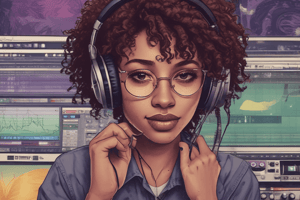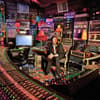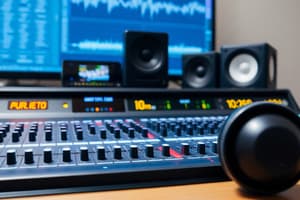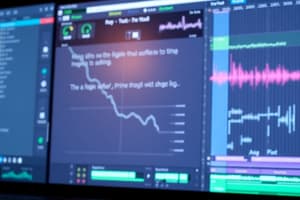Podcast
Questions and Answers
What is the purpose of the playback cursor in a Pro Tools session?
What is the purpose of the playback cursor in a Pro Tools session?
- To indicate the volume level
- To show the location of the timeline insertion (correct)
- To edit audio clips
- To display the main counter time scale
You can set the Main Counter to different time scales such as Bars|Beats, Min:Secs, and Timecode.
You can set the Main Counter to different time scales such as Bars|Beats, Min:Secs, and Timecode.
True (A)
What are the three primary editing tools in Pro Tools?
What are the three primary editing tools in Pro Tools?
Trim, Selector, Grabber
The timeline insertion location in Pro Tools is shown by the __________.
The timeline insertion location in Pro Tools is shown by the __________.
Match the time scale options with their descriptions:
Match the time scale options with their descriptions:
Which action describes moving the playback cursor to a desired location?
Which action describes moving the playback cursor to a desired location?
The Counters and Indicators in the Edit window can only display one type of time scale at a time.
The Counters and Indicators in the Edit window can only display one type of time scale at a time.
What is the recommended session to practice navigation if you don't have your own?
What is the recommended session to practice navigation if you don't have your own?
What happens if you click on the name of any timebase ruler in Pro Tools?
What happens if you click on the name of any timebase ruler in Pro Tools?
The Sub Counter can only display one time scale at a time.
The Sub Counter can only display one time scale at a time.
What two keys can you use to confirm an entry in the Main Counter or Sub Counter fields?
What two keys can you use to confirm an entry in the Main Counter or Sub Counter fields?
The ______ button in the Edit window toolbar controls whether the timeline and edit selections are linked.
The ______ button in the Edit window toolbar controls whether the timeline and edit selections are linked.
Match the methods of selecting a playback point with their descriptions:
Match the methods of selecting a playback point with their descriptions:
What is the purpose of the Trim tool?
What is the purpose of the Trim tool?
You can select the entire clip by triple-clicking with the Selector tool.
You can select the entire clip by triple-clicking with the Selector tool.
What key do you press to activate the Grabber tool?
What key do you press to activate the Grabber tool?
The standard Grabber tool is more properly called the ______.
The standard Grabber tool is more properly called the ______.
Match the tool with its primary function:
Match the tool with its primary function:
What happens when you hold the Option key while moving a clip with the Grabber tool?
What happens when you hold the Option key while moving a clip with the Grabber tool?
What does pressing the R key do in Pro Tools?
What does pressing the R key do in Pro Tools?
The Audio Zoom In/Out button can only zoom in on audio clips.
The Audio Zoom In/Out button can only zoom in on audio clips.
The Smart Tool is a single tool that performs all editing functions.
The Smart Tool is a single tool that performs all editing functions.
What do you need to do to activate the Smart Tool?
What do you need to do to activate the Smart Tool?
What does the Zoomer tool do in the Edit window?
What does the Zoomer tool do in the Edit window?
Pressing the ______ key activates the Selector tool.
Pressing the ______ key activates the Selector tool.
To activate vertical zooming, you can use the Audio Zoom _____ button.
To activate vertical zooming, you can use the Audio Zoom _____ button.
Match the zooming functions with their descriptions:
Match the zooming functions with their descriptions:
What is a function of the Selector tool?
What is a function of the Selector tool?
Double-clicking a clip with the Selector tool will select the entire clip.
Double-clicking a clip with the Selector tool will select the entire clip.
What happens when you hold the Shift key while scrolling with the mouse scroll wheel?
What happens when you hold the Shift key while scrolling with the mouse scroll wheel?
What does the Grabber tool allow you to adjust in your editing session?
What does the Grabber tool allow you to adjust in your editing session?
The Edit Keyboard Focus mode must be enabled for the R and T key shortcuts to work properly.
The Edit Keyboard Focus mode must be enabled for the R and T key shortcuts to work properly.
The ______ tool can be activated by clicking above the Trim, Selector, and Grabber Tools.
The ______ tool can be activated by clicking above the Trim, Selector, and Grabber Tools.
What color indicates that the Edit Keyboard Focus button is active?
What color indicates that the Edit Keyboard Focus button is active?
Match the key with its function in Pro Tools:
Match the key with its function in Pro Tools:
When using the scroll wheel on a Mac, holding the _____ key while scrolling up will zoom in.
When using the scroll wheel on a Mac, holding the _____ key while scrolling up will zoom in.
Match the following zoom control actions with their shortcuts:
Match the following zoom control actions with their shortcuts:
Which of the following methods is NOT mentioned as a way to zoom vertically?
Which of the following methods is NOT mentioned as a way to zoom vertically?
Holding the Alt key while scrolling down using the scroll wheel on Windows will zoom in.
Holding the Alt key while scrolling down using the scroll wheel on Windows will zoom in.
What is the purpose of vertical zooming in the Edit window?
What is the purpose of vertical zooming in the Edit window?
The Edit window's toolbar contains a cluster of buttons referred to as Zoom _____.
The Edit window's toolbar contains a cluster of buttons referred to as Zoom _____.
What happens when you double-click the Zoomer tool?
What happens when you double-click the Zoomer tool?
The 'No Scrolling' option allows the playback cursor to remain visible at all times.
The 'No Scrolling' option allows the playback cursor to remain visible at all times.
What are the three essential tools in Pro Tools for editing?
What are the three essential tools in Pro Tools for editing?
What color indicates that Slip mode is active?
What color indicates that Slip mode is active?
Shuffle mode ensures that clips can overlap.
Shuffle mode ensures that clips can overlap.
The Trim tool can be activated by pressing the ______ key.
The Trim tool can be activated by pressing the ______ key.
What is the primary purpose of Absolute Grid mode?
What is the primary purpose of Absolute Grid mode?
Match the scrolling options with their behavior:
Match the scrolling options with their behavior:
Which scrolling option allows you to always see the playback cursor?
Which scrolling option allows you to always see the playback cursor?
Activate Shuffle mode by clicking on the word ______ in the Edit window toolbar.
Activate Shuffle mode by clicking on the word ______ in the Edit window toolbar.
The Center Playhead mode allows seamless navigation of different sections on the timeline.
The Center Playhead mode allows seamless navigation of different sections on the timeline.
Which edit tool is best suited for fine-tuning clip positions while in Slip mode?
Which edit tool is best suited for fine-tuning clip positions while in Slip mode?
In Shuffle mode, moving a clip does not affect the positioning of other clips.
In Shuffle mode, moving a clip does not affect the positioning of other clips.
What mode should be selected at the top of the Edit window to properly use the Trim tool?
What mode should be selected at the top of the Edit window to properly use the Trim tool?
When 'Page' scrolling is selected, Pro Tools will ______ when the playback cursor reaches the right edge.
When 'Page' scrolling is selected, Pro Tools will ______ when the playback cursor reaches the right edge.
What will happen if you drag a clip onto an empty track while in Shuffle mode?
What will happen if you drag a clip onto an empty track while in Shuffle mode?
How does Continuous scrolling behave during playback?
How does Continuous scrolling behave during playback?
In order to adjust the grid value, click on the triangle icon next to the ______ in the Edit window toolbar.
In order to adjust the grid value, click on the triangle icon next to the ______ in the Edit window toolbar.
Using Continuous or Center Playhead scrolling consumes the least computer resources.
Using Continuous or Center Playhead scrolling consumes the least computer resources.
Which edit mode is best for aligning clips without gaps?
Which edit mode is best for aligning clips without gaps?
Relative Grid mode allows you to keep the same distance from a grid line when moving clips.
Relative Grid mode allows you to keep the same distance from a grid line when moving clips.
What visual indicator shows that the Trim tool is active in Pro Tools?
What visual indicator shows that the Trim tool is active in Pro Tools?
With the 'After Playback' option, Insertion Follows Playback is usually ______.
With the 'After Playback' option, Insertion Follows Playback is usually ______.
Match the Edit mode with its behavior:
Match the Edit mode with its behavior:
What visual indication shows that Absolute Grid mode is active?
What visual indication shows that Absolute Grid mode is active?
What does the Selector tool do?
What does the Selector tool do?
When using the Selector tool in Absolute Grid mode, selections will snap to the nearest ______.
When using the Selector tool in Absolute Grid mode, selections will snap to the nearest ______.
Which of the following modes is generally avoided for post-production work?
Which of the following modes is generally avoided for post-production work?
All edit modes can impact the timing of other clips when edited.
All edit modes can impact the timing of other clips when edited.
What color indicates that the Relative Grid mode is active?
What color indicates that the Relative Grid mode is active?
Spot mode is solely used for placing clips in specific time locations without any restrictions.
Spot mode is solely used for placing clips in specific time locations without any restrictions.
What is the keyboard shortcut for activating Shuffle Mode?
What is the keyboard shortcut for activating Shuffle Mode?
In Spot mode, the user can type a specific ______ for where a clip will be placed.
In Spot mode, the user can type a specific ______ for where a clip will be placed.
Match the editing modes with their descriptions:
Match the editing modes with their descriptions:
What field in the Spot Dialog box is used to change how time is displayed?
What field in the Spot Dialog box is used to change how time is displayed?
The Grabber tool cannot be used in Spot mode.
The Grabber tool cannot be used in Spot mode.
What time value is used to position the clip in the hypothetical example?
What time value is used to position the clip in the hypothetical example?
If you want your selected area to snap to a grid, use ______ mode.
If you want your selected area to snap to a grid, use ______ mode.
What happens when you repeatedly press the F4 key?
What happens when you repeatedly press the F4 key?
What happens when Loop Playback is activated?
What happens when Loop Playback is activated?
The Insertion Follows Playback option ensures that the playback cursor returns to the start after playback stops.
The Insertion Follows Playback option ensures that the playback cursor returns to the start after playback stops.
What visual indication shows the current position on the timeline in Pro Tools?
What visual indication shows the current position on the timeline in Pro Tools?
To enable Loop Playback in Pro Tools, you can choose from the Options menu to select ______ Playback.
To enable Loop Playback in Pro Tools, you can choose from the Options menu to select ______ Playback.
Match the actions with their results:
Match the actions with their results:
When scrolling using the vertical scroll bar in Pro Tools, what does clicking and dragging do?
When scrolling using the vertical scroll bar in Pro Tools, what does clicking and dragging do?
The playback cursor is visible even when it moves off the screen.
The playback cursor is visible even when it moves off the screen.
What keyboard shortcut is used to activate or deactivate Insertion Follows Playback?
What keyboard shortcut is used to activate or deactivate Insertion Follows Playback?
Playback will begin at the start of the selection and stop at the ______.
Playback will begin at the start of the selection and stop at the ______.
Match the playback and scrolling features in Pro Tools:
Match the playback and scrolling features in Pro Tools:
Which option allows you to quickly locate your playback cursor if it has moved off screen?
Which option allows you to quickly locate your playback cursor if it has moved off screen?
Session playback can only start from the left-hand edge of the timeline selection.
Session playback can only start from the left-hand edge of the timeline selection.
What feature allows you to adjust the visibility of different tracks in the Edit window?
What feature allows you to adjust the visibility of different tracks in the Edit window?
While scrolling horizontally in Pro Tools, you can use the ______ or right-facing triangle buttons on the lower edge.
While scrolling horizontally in Pro Tools, you can use the ______ or right-facing triangle buttons on the lower edge.
Flashcards
Counters and Rulers
Counters and Rulers
Counters and rulers show the location of the playback cursor and selected areas on the timeline.
Main Counter
Main Counter
The main counter displays the current time in your session, and can be set to show different units of time like bars, beats, minutes and seconds.
Main Counter Time Scales
Main Counter Time Scales
The main counter offers different time scales to help you navigate with precision.
Playback Cursor
Playback Cursor
Signup and view all the flashcards
Edit Window
Edit Window
Signup and view all the flashcards
Scrolling Options
Scrolling Options
Signup and view all the flashcards
Trim Tool
Trim Tool
Signup and view all the flashcards
Selector Tool
Selector Tool
Signup and view all the flashcards
Insertion Follows Playback
Insertion Follows Playback
Signup and view all the flashcards
Timeline Selection Playback
Timeline Selection Playback
Signup and view all the flashcards
Loop Playback
Loop Playback
Signup and view all the flashcards
Left-Facing Triangular Icon
Left-Facing Triangular Icon
Signup and view all the flashcards
Right-Facing Triangular Icon
Right-Facing Triangular Icon
Signup and view all the flashcards
Horizontal Scrolling
Horizontal Scrolling
Signup and view all the flashcards
Vertical Scrolling
Vertical Scrolling
Signup and view all the flashcards
Edit Tools Cluster
Edit Tools Cluster
Signup and view all the flashcards
Insertion Follows Playback Button
Insertion Follows Playback Button
Signup and view all the flashcards
Insertion Follows Playback Menu Item
Insertion Follows Playback Menu Item
Signup and view all the flashcards
N Key
N Key
Signup and view all the flashcards
Timeline Selection
Timeline Selection
Signup and view all the flashcards
Left Arrow Key
Left Arrow Key
Signup and view all the flashcards
Right Arrow Key
Right Arrow Key
Signup and view all the flashcards
Changing the Main Counter
Changing the Main Counter
Signup and view all the flashcards
Changing the Main Counter using Rulers
Changing the Main Counter using Rulers
Signup and view all the flashcards
What is the Sub Counter?
What is the Sub Counter?
Signup and view all the flashcards
Sub Counter Usage
Sub Counter Usage
Signup and view all the flashcards
Main and Sub Counter Synchronization
Main and Sub Counter Synchronization
Signup and view all the flashcards
Typing a Location
Typing a Location
Signup and view all the flashcards
Using Rulers to Select a Point
Using Rulers to Select a Point
Signup and view all the flashcards
Typing a Playback Area
Typing a Playback Area
Signup and view all the flashcards
Using Rulers to Select a Playback Area
Using Rulers to Select a Playback Area
Signup and view all the flashcards
Go to Zero
Go to Zero
Signup and view all the flashcards
Go to End
Go to End
Signup and view all the flashcards
Selecting From Playback Cursor to Beginning
Selecting From Playback Cursor to Beginning
Signup and view all the flashcards
Selecting From Playback Cursor to End
Selecting From Playback Cursor to End
Signup and view all the flashcards
Edit Selection
Edit Selection
Signup and view all the flashcards
Linked Timeline and Edit Selections
Linked Timeline and Edit Selections
Signup and view all the flashcards
Horizontal Zooming
Horizontal Zooming
Signup and view all the flashcards
Vertical Zooming
Vertical Zooming
Signup and view all the flashcards
Zoomer Tool
Zoomer Tool
Signup and view all the flashcards
Edit Keyboard Focus
Edit Keyboard Focus
Signup and view all the flashcards
Zoom Controls Cluster
Zoom Controls Cluster
Signup and view all the flashcards
Scrolling with a Mouse Wheel
Scrolling with a Mouse Wheel
Signup and view all the flashcards
Horizontal Zooming with Scroll Wheel
Horizontal Zooming with Scroll Wheel
Signup and view all the flashcards
Audio Zoom In/Out Button
Audio Zoom In/Out Button
Signup and view all the flashcards
MIDI Zoom In/Out Button
MIDI Zoom In/Out Button
Signup and view all the flashcards
Miniature Zoom Buttons
Miniature Zoom Buttons
Signup and view all the flashcards
Zooming in Pro Tools
Zooming in Pro Tools
Signup and view all the flashcards
Vertical Zoom
Vertical Zoom
Signup and view all the flashcards
R and T Key Shortcuts
R and T Key Shortcuts
Signup and view all the flashcards
Zooming In
Zooming In
Signup and view all the flashcards
Zooming Out
Zooming Out
Signup and view all the flashcards
Edit Window Scrolling
Edit Window Scrolling
Signup and view all the flashcards
No Scrolling
No Scrolling
Signup and view all the flashcards
After Playback
After Playback
Signup and view all the flashcards
Page Scrolling
Page Scrolling
Signup and view all the flashcards
Continuous Scrolling
Continuous Scrolling
Signup and view all the flashcards
Center Playhead Scrolling
Center Playhead Scrolling
Signup and view all the flashcards
Grabber Tool
Grabber Tool
Signup and view all the flashcards
Slip Mode
Slip Mode
Signup and view all the flashcards
Non-destructive Editing
Non-destructive Editing
Signup and view all the flashcards
F Key Customization
F Key Customization
Signup and view all the flashcards
Absolute Grid Mode
Absolute Grid Mode
Signup and view all the flashcards
Relative Grid Mode
Relative Grid Mode
Signup and view all the flashcards
Spot Mode
Spot Mode
Signup and view all the flashcards
Smart Tool
Smart Tool
Signup and view all the flashcards
Spot Dialog Box
Spot Dialog Box
Signup and view all the flashcards
Accessing Edit Modes with F Keys
Accessing Edit Modes with F Keys
Signup and view all the flashcards
Edit Modes
Edit Modes
Signup and view all the flashcards
Keyboard Shortcuts for Timeline Navigation
Keyboard Shortcuts for Timeline Navigation
Signup and view all the flashcards
Changing the Main Counter Time Scale
Changing the Main Counter Time Scale
Signup and view all the flashcards
Typing a Location in the Main Counter
Typing a Location in the Main Counter
Signup and view all the flashcards
What is Slip mode?
What is Slip mode?
Signup and view all the flashcards
Explain Shuffle mode.
Explain Shuffle mode.
Signup and view all the flashcards
What is Absolute Grid mode?
What is Absolute Grid mode?
Signup and view all the flashcards
How does Relative Grid mode work?
How does Relative Grid mode work?
Signup and view all the flashcards
How does Shuffle mode affect other clips?
How does Shuffle mode affect other clips?
Signup and view all the flashcards
How is the Grabber tool used in Slip mode?
How is the Grabber tool used in Slip mode?
Signup and view all the flashcards
How does the Selector tool behave in Slip mode?
How does the Selector tool behave in Slip mode?
Signup and view all the flashcards
How does the Trim tool work in Slip mode?
How does the Trim tool work in Slip mode?
Signup and view all the flashcards
What determines the grid spacing in Absolute Grid mode?
What determines the grid spacing in Absolute Grid mode?
Signup and view all the flashcards
What influences the Grid Value options?
What influences the Grid Value options?
Signup and view all the flashcards
How do you show the grid lines?
How do you show the grid lines?
Signup and view all the flashcards
How does the Selector tool behave in Absolute Grid mode?
How does the Selector tool behave in Absolute Grid mode?
Signup and view all the flashcards
How does the Trim tool work in Absolute Grid mode?
How does the Trim tool work in Absolute Grid mode?
Signup and view all the flashcards
Time Grabber
Time Grabber
Signup and view all the flashcards
Study Notes
Pro Tools Editing Fundamentals
- Pro Tools editing involves navigating and locating sections to edit.
- This lesson covers Navigation Tools and Editing Tools.
Navigation Tools
-
Counters: Top of the Edit window show timeline insertion point and selected area. A value typed into the counter moves playback.
-
Main Counter: Shows time scale (Bars/Beats, Min:Secs, Timecode, Feet+Frames, Samples). Changing the time scale changes the Edit Selection time scales.
-
Sub Counter: Displays a second time scale, useful for music projects.
-
Selecting Playback Points/Areas:
- Type location in Counter/Rulers to move playback cursor.
- Click on rulers to set start/end playback point.
- Type start, end, length in Edit Selection fields to select area.
- Drag sections on rulers to make selection.
-
Go to Zero/End: Return/Option+Return keys. Shift+Return/ Shift+Option+Return selects to beginning/end of timeline.
-
Timeline and Edit Selections: Linked via Options Menu ("Link Timeline and Edit Selection") or via the blue button on the toolbar in the Edit Window. Selection is mirrored timeline/track area.
-
Loop Playback: Selected area repeats until stopped. Option via Options Menu or right-click on Play Button.
-
Playback Cursor: Shows current position on the timeline. "Insertion Follows Playback" options can be toggled per active workflow; disabled jumps to original position, enabled stays at end of playback. Buttons/Menu/Hotkey (N) for enabling / disabling.
-
Playback Cursor Locating: Use triangular icons on rulers to locate cursor if it's off-screen. Left/Right arrow keys scroll to cursor.
Scrolling and Zooming
-
Scrolling: Horizontal & vertical scrollbars available. Click-drag/click triangle buttons for movement/tracks. Scroll wheel: Up/down vertical, Shift+scroll wheel controls horizontal.
-
Zooming: Change time shown in session. Shows more detail in clips but less time in the Edit window. Toolbar zoom buttons, corner zoom buttons. Hotkeys (R/T) for horizontal zoom in/out. "Edit Keyboard Focus" needed to activate zoom hotkeys (F keys). Scroll wheel: Holding Option/Alt will zoom.
-
Vertical Zooming: Zoom in/out vertically in audio waveforms, affects visual presentation not amplitude, to view low-amplitude areas. Click/drag, or hotkeys for increment. Separate Audio/MIDI Zoom buttons (top/bottom of toolbar). Use for vertical adjustments.
-
Zoomer Tool (F5): Zoom to an area or out. Incremental zoom/drag zoom/double click reset for vertical view.
Scrolling Options
- No Scrolling: No automatic scroll for playback.
- After Playback: Scroll to playback stopping point after play.
- Page: Scrolls to next section of timeline.
- Continuous: Set playback cursor to center of timeline as the view scrolls.
- Center Playhead: Center position when scrolling, restarts playback where you stopped.
Edit Tools
-
Trim Tool (F6): Adjust clip boundaries, non-destructive editing. Standard/TCE/Loop.
-
Selector Tool (F7): Click/drag on tracks/ruler for selections, used for cutting (Delete) or double/triple-clicks for clip/track selections.
-
Grabber Tool (F8): Time Grabber- moves clips to a new position or different tracks. Move/Copy (Option+drag) with grabber, double-click to rename.
Smart Tool
- Multi-function tool: changes edit tool based on mouse position, allows accessing multiple tools with single keystroke without switching buttons. Activates via button/F key combinations.
Edit Modes
- Slip: Flexible clip movement, no restrictions for using tools.
- Shuffle: Align clips end-to-end; clips move only if they are later on the timeline in this mode, suitable for song arranging..
- Grid: Two modes (Absolute/Relative).
- Absolute: Snaps to nearest grid line. Change grid value for spacing.
- Relative: Maintains the relative distance between the clip and the grid.
- Spot: Allows precise timing input by typing time values.
Additional Information
- Keyboard Shortcuts: Customizable. Reset to defaults through the "Setup" -> "Keyboard Shortcuts" menu.
- Edit Keyboard Focus is needed in some situations for Pro Tools to respond correctly to keyboard shortcuts. Usually enabled.
Studying That Suits You
Use AI to generate personalized quizzes and flashcards to suit your learning preferences.




